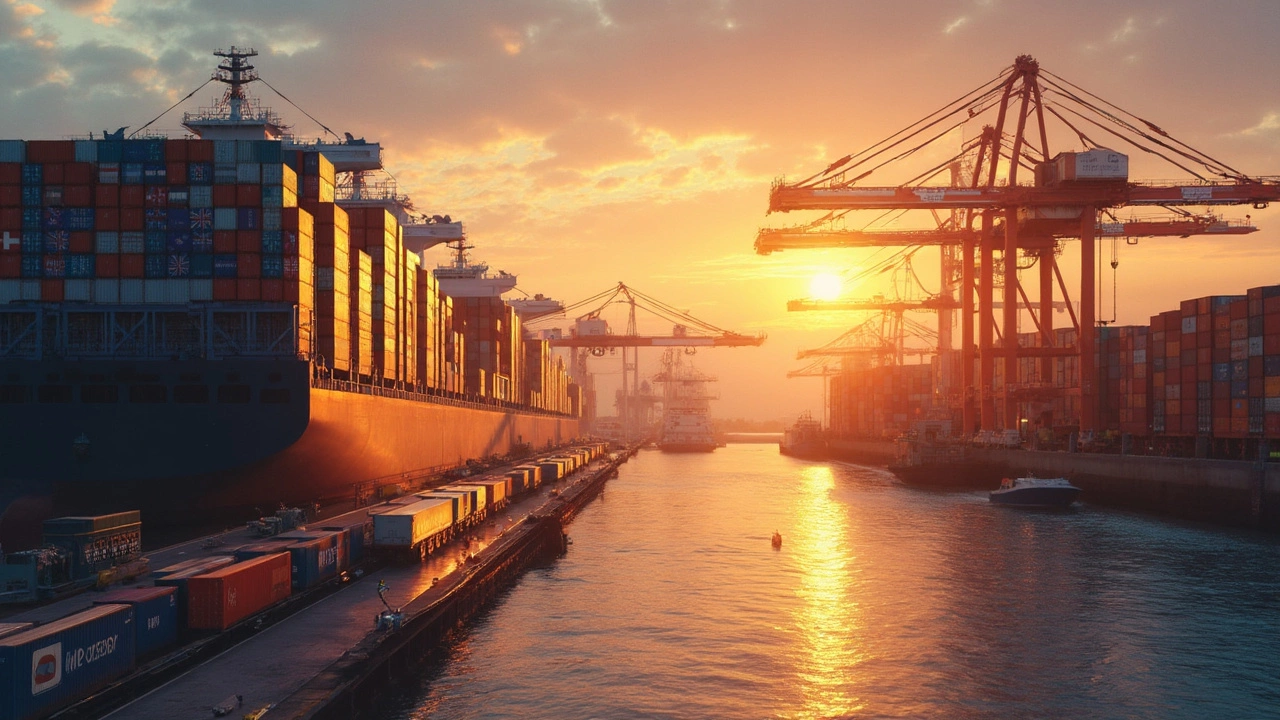If you’ve ever tried to ship a package overseas, you probably noticed something odd. Ship from one country, the price is peanuts—ship from another, and suddenly you’re eating ramen for a week to cover the cost. It’s not random. There are a handful of countries where shipping is just ridiculously cheap, and it’s all about how their systems are set up—and, sure, a dash of geography luck.
This isn’t just an issue for businesses; regular people feel the sting too. Say you’re running an Etsy shop out of your garage or sending family packages abroad—you know that shipping costs can make or break your plans. But here’s the catch: once you know the tricks, you can take advantage of the lowest-cost shipping hubs around the world, sometimes saving more than half what you’d pay elsewhere.
- Where Shipping Is Cheapest—and Why
- Top Countries With the Cheapest Shipping Rates
- Why Shipping Costs Change So Much
- Smart Tips for Cutting International Shipping Costs
Where Shipping Is Cheapest—and Why
You’d be surprised where shipping costs next to nothing. Countries like China, Singapore, Hong Kong, and the Netherlands are famous for their rock-bottom international shipping rates. China, in particular, has built a global reputation for the cheapest shipping thanks to massive government investment in logistics, low labor costs, and some aggressive deals with shipping companies. If you’ve ever snagged a dirt-cheap item online with free shipping from China, that’s no accident—China’s postal system actually gets international subsidies (thanks to global postal agreements aimed at helping developing countries).
Singapore is no slouch, either. With one of the busiest ports worldwide, high-tech logistics, and a government that loves smooth trade, Singapore keeps shipping rates low by making everything super efficient. Packages zip in and out almost faster than you can track them, making it a top choice for businesses looking to cut down international shipping bills.
The Netherlands, you ask? It’s all about the Port of Rotterdam. This mega-port acts like a highway on water, making it dirt cheap to ship just about anything to and from Western Europe. Add in a competitive local freight scene and fast customs, and you get some of the best shipping deals anywhere.
It’s not just about ports, though. Because countries like these have tons of international shipping volume, they negotiate better rates with global carriers. More packages mean economies of scale—it simply gets cheaper per parcel the more you send. Plus, if a government supports logistics with tech, infrastructure, and customs efficiency, the whole process is faster, less stressful, and a lot cheaper.
If you’re asking where the cheapest shipping countries are, look for places with huge ports, efficient transport networks, lots of cross-border trade, and cost-savvy governments. Those are the spots where shipping costs won’t leave your wallet gasping for air.
Top Countries With the Cheapest Shipping Rates
The cheapest shipping countries aren’t a big mystery—they’re leaders for a reason. Most of these places have massive shipping industries, tons of competition between carriers, and as a bonus, lower local costs for stuff like labor and fuel. They’re usually home to big ports, smart logistics systems, and bargain-friendly postal services. Let’s look at who’s at the top of the pile and why.
Cheapest shipping countries you hear about all the time include:
- China: The heart of global logistics. Thanks to government-subsidized postage and seriously bulk discounts on container shipping, China often ships tiny packages to the US and Europe for less than $2—sometimes under $1 if you’re using economy rates with companies like Yanwen or ePacket. Their domestic deals spill over for global shipments, which is why so much online stuff ships "free" from China.
- Singapore: Though the country is tiny, Singapore’s port is giant. The country sits on international trade routes, so businesses get competitive deals on both air and sea shipments. Singapore Post offers low base rates, and the customs process is pretty smooth, keeping extra costs down.
- Hong Kong: It’s technically a separate customs area from China, making cheap, efficient air and sea shipping the norm. Major players like Hong Kong Post and SF Express cater to both small sellers and giant e-commerce companies with some of the best international rates for lightweight packages.
- India: Thanks to huge improvements in logistics, India’s post and private carriers like DTDC and Blue Dart now offer super competitive exports, especially for light parcels going to the US, UK, and Europe. Plus, labor costs are some of the lowest globally.
- Netherlands: Shipping out of the Netherlands is popular in Europe because of Amsterdam’s Schiphol Airport and Rotterdam, the continent’s largest port. Dutch Post (PostNL) often undercuts its neighbors for EU-wide small parcel rates.
You’ll also hear about Malaysia, Vietnam, and Poland showing up in the low-cost crowd, especially as more businesses try alternatives to China.
Here’s a quick comparison showing sample economy rates in 2024 for sending a standard 1kg package to the US from a few of these shipping powerhouses:
| Country | Economy Rate to US (1kg package) | Main Shipping Service Used |
|---|---|---|
| China | $10 - $14 | Yanwen, China Post |
| Hong Kong | $13 - $17 | Hong Kong Post, SF Express |
| Singapore | $15 - $20 | Singapore Post |
| India | $14 - $18 | India Post, DTDC |
| Netherlands | $18 - $23 | PostNL |
These prices can be all over the place depending on exchange rates, fuel costs, and global disruptions like port strikes or lockdowns. But usually, these countries stay at the front of the race for rock-bottom rates.
So if you’re thinking about where to source your products or set up a fulfillment center for your online shop, choosing one of these countries might keep your shipping bills low. When Quentin asks why his soccer shoes from abroad took forever but cost almost nothing to ship, I can show him this list and data—real world economics in action. Not bad, right?

Why Shipping Costs Change So Much
Ever noticed that sending a package from China can cost way less than sending it from Canada? A bunch of things play into this, and there’s no single reason behind it. Let’s break down the big factors that make some countries shipping hotspots and others wallet-busters.
- Labor costs: Countries with lower average wages have a natural edge. For example, postal workers in Vietnam or India earn a fraction of what their counterparts make in Germany or Australia.
- Fuel prices: The cost to move a shipping container from one country to another depends a lot on local fuel prices and contracts with transport companies. Higher oil prices in some regions hit your shipping bill hard.
- Port fees and handling: Ports charge all sorts of fees—sometimes double or triple what you’d find in Southeast Asia if you’re shipping from Western Europe. The Netherlands manages Rotterdam, Europe’s busiest port, but port surcharges are way steeper than Singapore or Malaysia.
- Taxes, tariffs, and customs: Some countries pile on import/export duties or complex paperwork, adding hidden costs. Shipping out of the U.S. may sound cheap—until customs brokers and local taxes jack up your bill.
- Shipping volumes: The more stuff that comes in and out, the lower your per-package rate. The U.S. and China process millions of parcels daily, getting bulk discounts from major shipping companies.
- Geography: Inland countries pay more to reach a port. Kazakhstan can be three times pricier to ship internationally than coastal countries with huge ports like China or Singapore.
Here’s a simple table showing real differences in export shipping costs (as of late 2024) for a standard 2kg tracked parcel sent overseas:
| Country | Average Cost (USD) | Main Reason |
|---|---|---|
| China | $10 | High shipping volume, low labor |
| Vietnam | $12 | Low labor, easy port access |
| Germany | $26 | Higher wages, more expensive ports |
| Australia | $28 | Remote location, high local costs |
| India | $14 | Bulk export deals, low labor |
So, why is it way cheaper to send a package from China or Vietnam than Germany or Australia? It basically comes down to how much it costs to move goods, how efficient the ports and customs setups are, and how much volume shippers are dealing with.
If you’re looking for the cheapest shipping countries, always check the hidden fees, the paperwork hassle, and even exchange rates. That’s where costs sneak up and surprise you.
Smart Tips for Cutting International Shipping Costs
Shipping internationally doesn’t have to be a wallet-buster. Millions of online sellers, small businesses, and everyday people shave big bucks off their shipping bills with a few smart tweaks. If you want to leverage the cheapest shipping countries, it really comes down to knowing the best moves and avoiding classic mistakes.
- Bundle Whenever You Can: Shipping a bunch of small packages costs more per item than batching them into one larger box. Most carriers offer price breaks as your package gets heavier, thanks to bulk pricing.
- Skip Extra Add-ons: Insurance, express options, door-to-door tracking—they all sound nice but drive up costs fast. Only pay for what you truly need. For low-value shipments, basic tracking usually does the trick.
- Use Third-Party Shipping Platforms: Sites like Pirate Ship, Easyship, and Shippo tap into global carrier discounts that regular people can't usually get. These platforms let you compare rates from different carriers instantly, so you always know if there’s a better deal.
- Check for Shipping Hubs or Forwarders: In some countries, freight forwarders and local drop-off hubs cut costs drastically. For example, mailing from China, Singapore, or Hong Kong often means rock-bottom rates, especially with well-known forwarders and consolidators.
- Avoid Overpaying for Packaging: Carriers often charge by "volumetric weight." Use the smallest possible package and avoid wasted space, or you’ll pay for air—which is basically money down the drain.
- Know the Cutoff for Customs Fees: Some countries (like the US with its $800 de minimis threshold) allow packages below a certain value to skip customs fees altogether. If you’re shipping products, try to stay under these thresholds for each destination.
It helps to see how little tweaks add up. Here’s a quick peek at real-world price differences based on 2025 data for shipping a 2 kg (about 4.4 lbs) package to the US from different countries using standard international mail:
| Country | Cost (USD) | Estimated Delivery Time |
|---|---|---|
| China | $18 | 10-20 days |
| Singapore | $22 | 8-14 days |
| India | $24 | 10-16 days |
| Poland | $29 | 8-15 days |
| USA (domestic) | $12 | 2-5 days |
Those differences stack up fast over dozens of shipments. For businesses, that’s thousands in savings annually. Everyday folks feel it, too—ask anyone sending care packages or running small e-commerce gigs across borders.
Oh, and here’s a hidden gem: international "flat rate" boxes. Carriers like USPS, Canada Post, and Australia Post offer flat rates for certain box sizes, regardless of weight (up to a max limit). These are lifesavers, especially for heavier stuff, and usually come with basic tracking included.
In short, with a bit of homework and a willingness to try new platforms or logistics partners, you can shrink those international shipping fees way down. Even the smallest effort—like comparing rates before clicking ‘ship’—pays off after just a few packages.


